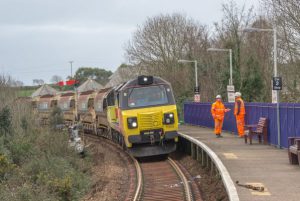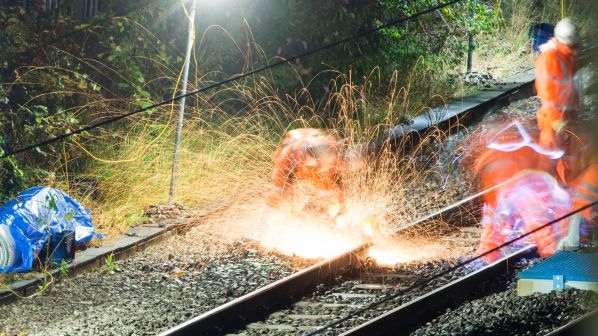THE past year has been difficult for the nearly five million passengers and businesses which rely on Britain’s railway. Major disruptions caused by the introduction of a new timetable in May, coupled with the failure of Network Rail (NR) to complete several major projects on time and to budget, caused frustration and anger among rail users.
However, with NR set to finalise its plans for the next five-year funding period, Control Period 6 (CP6), by the end of March, the infrastructure manager considers this as an opportunity to turn the situation around and create a marked improvement for freight customers and passengers.
“We know that it’s been really tough for passengers recently and we have an opportunity to bring about real change, focusing on putting passengers and freight users at the front and centre of what we do,” says Mr Charles Robarts, NR director, planning and regulation. “There are challenges ahead, but we will make this funding work hard over the next five years to deliver a better and more reliable railway for the 4.7 million people and businesses that use it every day.”
Each periodic review outlines the outputs and funding available to NR for a five-year period from the British government and the devolved Welsh and Scottish administrations, and how specifically the money will be spent. Two separate documents reflect the different funding and legislative requirements in Scotland.
The two-year process of developing the CP6 began with the launch of the Office of Rail and Road’s (ORR) periodic review (PR18) in May 2016. The strategy passed its final hurdle with the release of ORR’s final determination on October 31 last year, and NR is due to release the final plan by March 31.
The review is the first to take place since NR was reclassified as a public sector body, meaning its funding is now effectively fixed. In addition to NR’s eight routes, an additional route, Freight and National Passenger Operators (FNPO), will be established in CP6 to look after nationally-focused operators whose interests extend across NR’s geographical routes boundaries.
“While there are areas that still need to be improved, the quality of these plans is better than in the 2013 periodic review (PR13), with a real sense that each route management team feels fully accountable for its plan,” the ORR says.
NR says the emphasis has changed from CP5 in that individual routes have a greater degree of freedom to decide how funding is spent. Each route has been allocated funding, ranging from £1.9bn for Wales up to £8.7bn for London North Western (LNW) (see panel) and the hope is that this will speed up decision making while also focusing management attention on local issues. The System Operator (SO), a specific business unit set up within the company in 2017, will oversee the effective planning and coordination of the rail network.
“These plans have been informed by ongoing customer engagement which will continue through CP6, with routes developing their understanding of customer priorities,” Robarts says. “Each route has developed its own plan based on knowledge of its network and its customers. Routes have developed efficiency plans using a consistent framework to allow comparison between routes. The key effect of route ownership will be increased confidence that our CP6 plan has the right balance between being challenging and achievable.”
Robarts says the SO’s focus for CP6 includes:
- a more iterative and ‘modular’ form of strategic planning, analysing the future needs of the network and working with the industry to advise funders on the options for how the network should develop over the longer-term, which should be better-aligned with key franchising and rolling stock decisions and informed by more effective stakeholder engagement
- improved provision of advice to a wider number of funders relating to future projects and franchising decisions
- a more accurate and resilient timetable, and
- more automated timetable processes and a move towards ‘per second’ timetabling rather than the current practice of planning the timetable in 30-second increments. This will be delivered through increased investment in NR’s technological capabilities.
“We recognise the need to take account of the lessons learnt from the ongoing investigation into the May 2018 timetable change in the development of our CP6 SO plan, and anticipate that the steps set out in the SO strategic plan, and actions undertaken since, are likely to complement the lessons learnt,” Robarts says. “The SO is in the process of updating its CP6 plans consistent with ORR’s Final Determination, which will be set out in the overall CP6 plan to be published by March 31.”
A major criticism of NR in the past has been its lack of efficiency, with the ORR noting in its final determination for England and Wales that NR has performed poorly when carrying out renewals.
A 2017 ORR report attributed this to inadequate preparation at the start of CP5, and noted that NR’s efficiency improvement plans included in PR13 were not well-founded. The report states NR’s response to the problem was too slow and there was increased pressure on access to the railway to carry out work.
NR appears to have addressed this situation in its CP6 planning. The ORR found that NR is committed to delivering efficiencies of £2.6bn over the five-year period corresponding to a 10% efficiency improvement.
“Our response to ORR’s draft determination included an increase of around £500m of cost savings, compared with our February 2018 CP6 Strategic Business Plan,” Robarts says. “By the end of CP6 these savings will represent a reduction in our operating, maintenance and renewals costs of around 12%, or nearly 10% once headwinds have been accounted for. Significant improvements in our business planning at a route level will drive more efficient delivery in CP6. Efficiency savings will also be achieved through smarter working, more efficient use of the railway and better technology.”
ORR noted that NR could still further improve efficiency, but said on balance it had decided to accept the routes’ proposals for CP6. ORR says the expected improvements will also allow a heightened rate of renewals, supporting asset sustainability.
At the same time, the regulator raised concerns about the profile of expenditure, which it says continues to show a significant ramp up of work in the middle of CP6, with a reduction over the longer-term.
“If risks are managed effectively, the release of the risk funds will allow increased spend in the later years of the control period, which would act to smooth the spending profile,” ORR says in its final determination. “This is, of course, not guaranteed. Reflecting this, we expect NR to improve engagement with the supply chain, and the information available on the likely volume and nature of work in each year. This will be particularly important given the potential impacts from Brexit.”
CP6 includes a focus on staffing levels, and NR has set an ambitious target of increasing the number of women in the workforce by 50%.
“We plan to achieve these targets by tackling unconscious bias in the recruitment process, introducing diverse recruitment panels, and encouraging young women and girls to study Stem (science, technology, engineering and mathematics) subjects,” comments NR director of diversity and inclusion, Ms Loraine Martins. “Our extensive early engagement programme is led by women as role models who can address any misconceptions girls may have about rail.”
The Scotland route is divested with separate funding and a requirement to meet the Scottish government’s High-Level Output Specification (HLOS), and ORR has therefore published a separate final determination specifically for the route. Included in the HLOS is a requirement to meet 92.5% of the Public Performance Measure (PPM) over CP6, which NR says it does not expect to achieve until the third year of CP6, based on current performance.
“ORR has noted that if the Scotland route fails to deliver this target, it will take into account the route’s implementation of the recommendations from the Donovan Review,” Robarts says. “This will inform its consideration of whether the Scotland route has done everything reasonably practicable to achieve the 92.5% PPM, along with the other steps it has said it will take to improve performance.”
Donovan Review
A review carried out in April 2018 by Mr Nick Donovan, previously Northern Powerhouse Rail director for Transport for the North, studied ScotRail’s processes and made 20 recommendations to improve performance on the Scottish network.
The HLOS has also charged NR with making rail freight more attractive to businesses across Scotland and facilitating 7.5% growth by the end of CP6, for which Robarts says NR is developing a plan.
 “This will demonstrate how NR and the freight industry will take all reasonable steps to facilitate growth of 7.5% in rail freight traffic carried on the Scotland route by the end of CP6,” Robarts says. “This plan is being developed by the FNPO route as part of NR’s overall CP6 plan update and will be finalised by March 31.”
“This will demonstrate how NR and the freight industry will take all reasonable steps to facilitate growth of 7.5% in rail freight traffic carried on the Scotland route by the end of CP6,” Robarts says. “This plan is being developed by the FNPO route as part of NR’s overall CP6 plan update and will be finalised by March 31.”
The final determination includes a turnaround from the draft CP6 in the amount NR will spend on research and development (R&D), which the ORR says was originally poorly justified.
“In response to our challenge, NR has revised its plans, provided significant supporting evidence and updated its proposed governance arrangements,” ORR says. “In light of this new evidence, we support a Britain-wide fund of £245m, of which £26m will be funded from the Scotland route settlement, for R&D in CP6.”
The expenditure is still subject to the finalisation of suitable governance arrangements that also need to be agreed with ORR. The regulator says it will be looking at how that governance supports third-party funding and accommodates the interests of passengers, freight customers, funders and train operators.
“We have focussed on R&D activity that drives improvement of infrastructure management with a heavy emphasis - 55% - on asset sustainability, which we estimate will drive at least £2.2bn of benefits in reduced renewals over the next 20 years across the whole network,” Robarts says.
Along with the final CP6 report, in which NR will show how it will incorporate the changes required by the ORR in its final determination, the infrastructure manager is also due to publish the final CP6 price lists by March 31. This will include updating billing systems and contracts to reflect ORR’s decisions on CP6.
With Britain apparently set on a path to leaving the European Union on March 29 with or without a deal, the landscape is set to change dramatically in 2019. Coupled with the timetabling review and the Williams review, NR is in for an interesting time over the next five years. As the ORR says, CP6 is about a return to basics, and getting them right.

